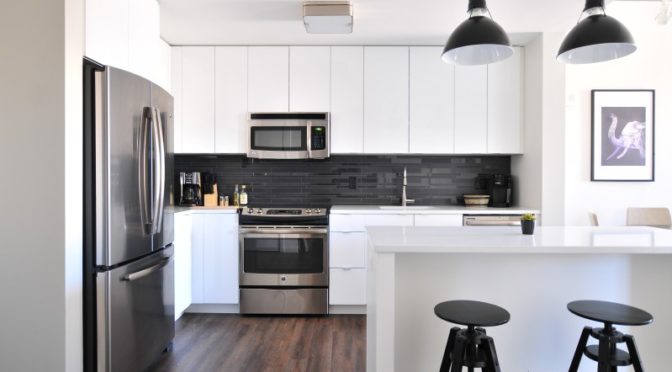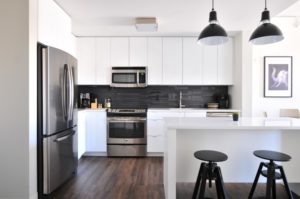
Solid hardwood floors are beautiful, and when well cared for, can last for generations. However, unlike porcelain or ceramic tiles or vinyl or concrete, which you can install just about anywhere in your home, hardwood floors are more particular. You simply can’t install them in areas that are likely to see a lot of moisture; common examples include full bathrooms, which feature bathtubs, showers, sinks, and toilets, as well as 3/4 bathrooms, which feature everything in a full bath besides the bathtub. However, the kitchen counts as a semi-moist area, which makes it a more tricky question to answer. Today we’ll examine which circumstances make installing a hardwood floor in a kitchen a good or bad idea.
How much moisture will you find in a kitchen, and when is it too much?
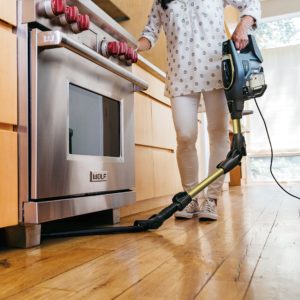
It helps to think of water damage possibilities on a continuum. On one end, you have places that are flooded or face standing water on a continual basis, such as full bathrooms and poorly sealed basements without working sump pumps. No organic floors–solid wood or carpet–will work in such environments. On the other end, you have bone dry rooms that almost never see water; bedrooms are a good example. Kitchens fall in the middle of the continuum.

While you might occasionally drop a pot of soup or a glass of water in a kitchen, it’s not a continually wet environment in most homes, and the occasional spills promptly attended to won’t have significant effects on wooden floors. What you really want to think about are larger, disaster-scaled events, such as a pipe bursting while you’re on vacation, a refrigerator leak, or a dishwasher seal break leading to a flooded kitchen floor.
That said, if your floor sealant holds, moisture won’t penetrate your wood surface. Similarly, you can make laminate flooring work in wet environments as long as you install the planks closely enough to keep water out of the seams.
To use hardwood floors in kitchens, consider site finished wood

You can increase your odds of a successful hardwood kitchen install by using unfinished floors, also known as “site-finished”, instead of pre-finished wood. This wood arrives in your home in raw form, without staining or sealant. Once your installers have stapled it to your subfloor, they seal it and stain it if you want.
Pre-finished solid wood, in contrast, is sealed and stained by the manufacturer and arrives at your home ready to go. However, although both pre- and site-finished wood will eventually be tongue-and-groove connected, pre-finished wood won’t have sealant covering the seams that separate each board, resulting in less protection against water. Site-sealed wood will include a sealant layer that covers the entire floor, bridging seams that would otherwise let water in over time.
If it doesn’t have to be hardwood, try engineered wood floors

Unless you’re married to the idea of using genuine hardwood floors, you might want to consider engineered wood flooring instead. These floors are real wood; they’re just not fully hardwood. Rather, they include a hardwood veneer a few fractions of an inch thick on top of a plywood base. Because plywood is more water resistant than hardwoods, the floor will stand up better to moisture if the veneer is penetrated by water.
Additional factors that may affect hardwood durability in kitchens

Aside from moisture, keep traffic in mind. Unless you live alone and never have friends or family over, many people will pass through your kitchen over time. With the years, you’ll often find trails through your kitchen floor that follow foot traffic. Relatively speaking, though, this is a minor issue that you can address by sanding your floors.
Scratches, dents, and dings are another risk to keep in mind when using hardwood floors in kitchens. If you drop a jar of pickles or a can of beans on your floors, you’re probably going to see a dent. But on one hand, this probably won’t happen that often. And on the other, you can add area rugs and runners to protect the floor from impacts. Then there’s the perspective that these kinds of marks add “character” to your floor, which is generally a good way to look at any cosmetic damage.
That said, if you choose throw rugs to protect your wooden floors, you’ll likely end up with sun bleaching on the areas that aren’t protected. Keep this in mind if you have a kitchen exposed to strong sunlight and a floor stained in dark colors; you might end up needing to restain your floors if this bothers you over time.
Are there particularly good vacuums for polishing and maintaining hardwood floors in kitchens (or elsewhere)?
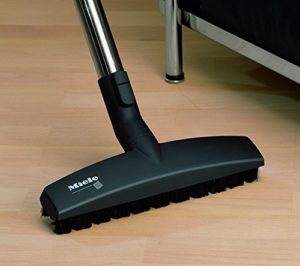
While you can use even a cheap box store vacuum to clean a hardwood floor, we always recommend spending a bit (or a lot) more to get machines with interchangeable heads. Why? Because a Parquet head will treat your hardwood floors better than just about anything else, while a powered electric head will clean dirt out of carpets with a power and efficiency you simply won’t get from an air powered head.
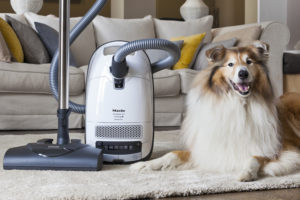
A Parquet head polishes bare floors while picking up dirt, dust, and pet hair instead of simply pushing it around; it’s a quality investment for quality floors. Two vacuums that include both Parquet and powered brush heads are the Miele Complete C3 Cat & Dog (reviewed here and here) and Miele Compact C2 Electro+ (reviewed here and here); they’re also two of the best vacuums on the market at any price, and will last for decades longer than budget vacuums.
![]() You can buy the Miele Complete C3 Cat & Dog here on Amazon or buy the Miele Compact C2 Electro+ here.
You can buy the Miele Complete C3 Cat & Dog here on Amazon or buy the Miele Compact C2 Electro+ here.
![]() Canadians can buy the Miele C3 Cat & Dog here or buy the Compact Electro+ here.
Canadians can buy the Miele C3 Cat & Dog here or buy the Compact Electro+ here.
 If you find our research on PMC helpful, you can follow our efforts to keep maniacally reviewing home cleaning tools by shopping through our links above. We promise to keep fighting the good fight against every horror children, animals, and grown, yet messy humans can inflict upon a clean home.
If you find our research on PMC helpful, you can follow our efforts to keep maniacally reviewing home cleaning tools by shopping through our links above. We promise to keep fighting the good fight against every horror children, animals, and grown, yet messy humans can inflict upon a clean home.

